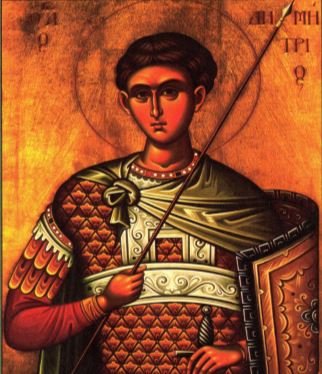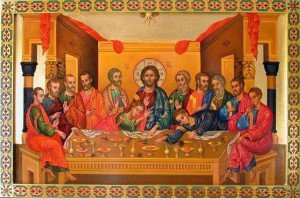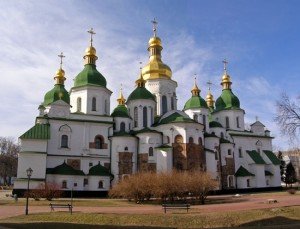DEMETRIUS – son of one of the preeminent families of Thessalonika, he was an officer in the Roman army. He organized the Christian youth of the city. Because of his social standing, he was not originally persecuted. In 303, however, a Roman decree led to his execution in the city’s stadium. The Byzantine armies considered him their patron.
As I shared in last week’s Bulletin, we cannot grow in a personal relationship with God without prayer. The foundation for any real relationship with God is prayer. The evangelists, especially St. Luke, tell us that Jesus frequently went off to pray. Prayer was the foundation of the spiritual journey of Jesus. (We sometimes fail to realize that Jesus, the man, was confronted with the same need to have a relationship with God and, like us, had to develop this relationship through prayer). He spoke frequently about his relationship to God. The disciples of Jesus found his way of relating to God and of praying very attractive. They wanted to pray in the same way, so that they would eventually have the same type of relationship. What was unique about Jesus’ form of prayer was that it was quite personal. He addressed God as Abba, or Father. The prayer of His people and family was much more formal. They would not have thought of God in such a very personal way. “One day Jesus was praying in a certain place. He modeled for His disciples the necessity of prayer. When he had finished, one of his disciples asked Him, Lord, teach us to pray as John taught his disciples. Jesus also modeled for His followers that they could pray anywhere, not just in the synagogue.
Those early Christians who believed in Jesus believed in reaching out to God in prayer. St. Paul encouraged his friends in Thessalonica to pray always. In his letter to the Romans, Paul pointed out that people do not always know how to pray and may need help in praying. He wrote that the help they needed was always at hand.
One of the special contributions Christianity has made to human history is the understanding that prayer can be a conversation with a personal God. Christianity has also promoted the understanding that humans can have a personal relationship with God, which is, in truth, a radical change in man’s concept of God.
God as Father is truly a wondrous revelation!
In the last several issues of this article I have begun sharing thoughts about the Letter of St. James, considered to be the Brother of the Lord and the First Bishop of Jerusalem. This letter, which is the only one attributed to him and contained in the New Testament (NT) canon, is one of seven letters that have been given the title “catholic”. The seven letters are: James, 1, 2 and 3 John; 1 and 2 Peter and Jude. This title has been given to these letters because they appear to lack specific addressees and therefore can be directed to the whole church. It should be noted that the inspired character of these letters was disputed in the early church and only accepted as inspired at the beginning of the fifth century.
The author of this letter concerns himself entirely with Christian conduct. He writes in the spirit of the Old Testament wisdom literature and of the moral teaching of Tobit or Tobias (Found in Catholic and Orthodox editions of the Old Testament). Although it is usually listed with the historical books, it more correctly stands midway between them and the wisdom literature. It contains numerous maxims like those found in the wisdom books. From his letter, it is evident that James was influenced by the tradition of moral exhortation that was in Judaism.
In Christian history, James has sometimes been controversial. Martin Luther called it “an epistle of straw” and wanted to excise it from the NT. Paul’s message of justification by grace through faith” was for Luther the heart of Christianity and he thought James emphasized “works” too much.
You will recall that Protestantism is known by the fact that it asserts that faith alone is needed for salvation. Catholic and Orthodox Christians maintain that faith and good works are needed since faith without good works is meaningless. Good works provide the evidence necessary to demonstrate that a person truly believes in Jesus as Redeemer and Lord.
Few Christians today would be bold enough to advocate throwing a book out of the Bible. But many have perhaps unknowingly sided with Luther’s verdict on James, that what matters most is what we believe and not what we do. James called his audience beyond belief to action: Be doers of the word, and not merely hearers. Rather than being an epistle of straw, it is a fiery and passionate letter.
Finally, it should be noted that James echoes more sayings of Jesus than any document in the NT other than the gospels themselves. Its fiery passion reflects the passion of Jesus Himself.
James was the adviser of Paul on the latter’s arrival in Jerusalem. The letter is datable before 62 CE when James was executed in Jerusalem. It is a source for the Anointing of the Sick as a sacrament
The New Testament (NT) has Jesus say, “Do this in memory of me”. He does not say how often and the problem before us is the various answers given to that question throughout history. In considering this point, we must consider the established Christian Eucharistic tradition in this command to repeat reported by Luke and Paul in First Corinthians though not by Mark or Matthew. Whether Jesus actually said it and whether what ultimately emerged as the Eucharist goes against the original expectation of an imminent parousia (i.e., the second coming of Jesus) cannot be discerned.
The main interest here is not the frequency of communion (i.e., with what frequency the faithful actually received the Eucharist) but rather with what frequency the liturgy was celebrated or communion made available to communicants.
From the NT we can conclude nothing certain about eucharistic frequency. All were assiduous at the breaking of the bread, though how often is not indicated: the daily of Acts 2:46 refers with certainty only to the temple prayer. An incipient Sunday rhythm may be implied in Acts 20:7-12 and 1 Corinthians 16:2, and one might infer the same from the meals of the Risen Lord on the first day, or from the parallelism between the Lord’s Supper and the Lord’s Day in Revelations 1:10.
By the middle of the second century, however, the picture is clear: for the community synaxis (gathering), Sunday and Eucharist form a unity as the symbolic celebration of the presence of the Risen Lord amidst his own, a presence that signals the arrival of the New Age. And it is generally agreed that everyone present communicated.
Although this Sunday Synaxis was initially the only common Eucharist, it was customary for the faithful to take from it enough of the blessed gifts for communion during the week. The evidence for this from Tertullian on is unquestionable. This practice of communion outside Liturgy lasted among the laity until the seventh century, and even longer in monastic circles.
So the practice was that the elder of the home, typically the father, would take enough communion home with him to be distributed to the family during the week at a meal. A special place was reserved in the home for keeping the eucharist.
By the end of the second century we also see a filling out of community worship. Liturgies were celebrated at martyrs’ tombs on the anniversary of their victory. Saturday is gradually assimilated to Sunday and by the fourth century has acquired a eucharistic celebration everywhere except Rome and Alexandria. Like all things in the Church, weekly Liturgy was a gradual development
The parable of the Sower appears in all three of the Synoptic Gospels. This fact suggests that it may truly have been one of the parables actually said by Jesus, Some scholars suggest that a better name for this parable would be the parable of the different sowings.
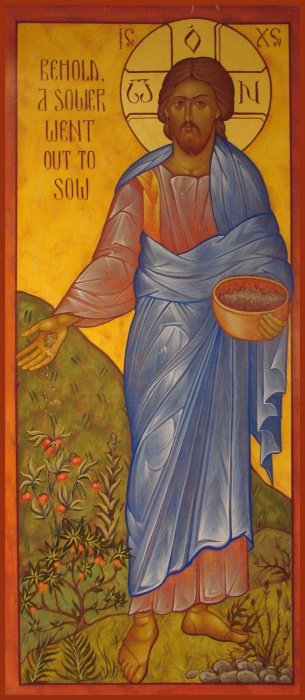 Think about the context of the parable. The sower walks over a field, fallow since the harvest, covered with thorns and crossed by a footpath made by trespassers. It is ready for seeding, having been softened by the first rains. It is important to note that in Palestine ploughing comes after sowing. This then explains why the seed falls where it does. Once sown, the seed is ploughed under and all else with it – the thorns and the footpath as well. What is essential is the ploughing of the soil so that the seed has a good, rich environment in which to grow.
Think about the context of the parable. The sower walks over a field, fallow since the harvest, covered with thorns and crossed by a footpath made by trespassers. It is ready for seeding, having been softened by the first rains. It is important to note that in Palestine ploughing comes after sowing. This then explains why the seed falls where it does. Once sown, the seed is ploughed under and all else with it – the thorns and the footpath as well. What is essential is the ploughing of the soil so that the seed has a good, rich environment in which to grow.
There are various interpretations for this parable. One possible interpretation, which I believe has a greater meaning for us, focuses on the hearer’s reception of the teaching of the Lord. It is one thing to hear the teachings of Jesus and another to allow the teachings of Jesus to take root in your heart and grow. This interpretation of the parable challenges us, the hearers, to open our hearts and minds to the Lord’s teachings and allow His way of living to take root in our lives. This, of course, requires work on our part. We must soften our hearts and minds by ploughing under those things in our lives that keep us from fully and completely hearing the teachings of Jesus and then truly incorporating Jesus’ ways of looking at and thinking about life into our lives.
For example, too often we hear the words love your enemies and, while we acknowledge that these are words are truly the words of Jesus, we find a million reasons why living in a manner which expresses love for our enemies is totally impossible and/or unrealistic. We humans easily make excuses for our prejudices. While we know the rules of living that Jesus gave us, we are very prone to make excuses why we judge others, refuse to forgive others and consider others less than ourselves. There are no excuses, truthfully, why we should hate others and condemn others, even those who hate us and are attempting to hurt us.
I know that this is contrary to the way our modern society thinks. I know that the fear that is presently quite prevalent in our modern world militates against an easy acceptance of this essential teaching of Jesus. Nevertheless, the followers of Jesus are called to truly love those who hate. I also know that the only way that we can change our thinking is, perhaps, through prayer and fasting. I know that our modern world can be very scary. I know that our modern world is filled with hatred, selfishness and greed. I also know that God has called us to live like Jesus did!
I don’t know whether this article on the Divine Liturgy is making any sense to my readers. I thought that I would regroup and focus a little more on my understanding of the Liturgy. I’ve tried to give a little history about the Liturgy and some background information about the Liturgy.
As all of my readers probably know, the Jewish tradition called for not only a synagogue/temple service but also a Sabbath Day meal. The two customs were separate, although all truly sincere Jewish people observed both.
A majority of the early Christians were, of course, Jewish. This included the disciples and apostles. They were truly accustomed to observe both! Jesus Himself observed both. There was always also a very special meal for the feast of Passover which was different from the regular Sabbath meals.
The early Christians participated in the synagogue/temple services and then, like all good Jews, also had a special Sabbath meal. But, because Jesus said some special things at the last meal He had with His disciples – He suggested that the bread and wine that they used at the meal was truly His Body and Blood – they turned their regular Sabbath meal into a time when they remembered Jesus and His teachings in a special way. As they shared the meal, Jesus was truly present to them through this remembrance. They also continued, however, to use the worship ritual of Judaism by going to the temple/ synagogue.
The change did not happen overnight! Rather it took years for them to combine their worship of God with the special meal that they offered, remembering exactly what Jesus did during His last meal with the apostles/disciples.
During the special Sabbath meal, which eventually became the worship ritual of the Christians, people would share stories about Jesus and also talk about what they believed Jesus taught. If they received a letter from one of the Apostles or disciples who went around establishing small communities (i.e., churches), they would also read these letters. So the meal and the worship became one event.
Of course a problem arose. Wine was always served during these meals. It was a custom. People sometimes imbibed too much wine and so the special meal became less reverent. Paul was one of the apostles that recognized this and insisted that the meal be served earlier in the day and without extra wine – sharing only the wine that was prayed over to make it the Blood of Christ.
Gradually, because the service became a morning service, it took on a different feeling and meaning. It then became a symbolic meal that served as a worship ritual, much more like temple worship
The Call to Holiness is a Call to Take a Journey. The journey we are called to is a spiritual journey – a journey in search of the true meaning and purpose of life.
There are two very different attitudes we can choose about this spiritual journey. Our decision will affect how we see God and how we act. One possibility is to think of the spiritual life as a call to be perfect. Seeking perfection, if by perfection we mean a finished product or a life without any mistakes or problems, is not a very helpful attitude because it implies a goal that is static and closed. When we think of perfection in this way, we too easily see life as a question of black and white. We tend to think of ourselves and of others as either good or bad, in the state of grace or in the state of sin. In this view, if there is any movement in our lives, it is like jumping in and out of the pool of grace or bouncing on or off the trampoline of sin. We tend to see God as a judge and a scorekeeper, and judge ourselves by how perfectly we keep the rules. If we do keep them, we think of ourselves as having arrived, as being among the saved. It betrays an attitude that says: God loves me if I keep all the rules and punishes me if I don’t. It surly doesn’t recognize God’s revelation through Jesus that we are the Temples of God’s own Spirit.
The other possibility is to think of the spiritual life as a process, a pilgrimage or journey that is never finished as long as we are breathing. With this attitude, we see both good and bad in ourselves. We realize that we are neither good nor bad, but someplace in-between. We are conscious that both grace and sin are working in us, that we are far from finished products. That we always have the potential for more growth. We recognize that sin is part and parcel of our journey, but we do not see sin as a sign of total failure. Rather, we see sin as a part of a larger reality, of a greater redemptive story. We realize that the only fatal mistake is stopping on our journey, because stopping leads to stagnation, even to spiritual death.
To begin thinking in this fashion takes change. We must realize that life is given to us, with all of its challenges and successes, to help us grow. There is no real limit to the growth that we can make. There will never be a time when we will no longer need to grow or change.
For some reason, lots of people think of death as bringing a life that never is challenged and is static. It would be horrible, in my estimation, to think that eternal life means that I will never have to change. How boring! Change, although it is hard at time, is the ultimate sign of life. It is exciting and wonderful. Think about this!
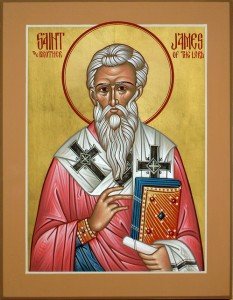 It is the letter of James that states that the gathering of a Christian group is referred to as an assembly – the Greek word for assembly is the one from which we derive synagogue.
It is the letter of James that states that the gathering of a Christian group is referred to as an assembly – the Greek word for assembly is the one from which we derive synagogue.
There is little in this document that is overtly theological, nothing about the death and resurrection of Jesus, nothing about doctrines that are to be believed. Its focus is primarily practical, combining wisdom about how to live and prophetic indictment of how people commonly do live. Half of James’ 108 verses are imperatives.
The author emphasizes the importance of doing and acting. Two of the best known passages are: be doers of the word, and not merely hearers…doers who act and Faith without works is dead. His examples of works are concretely compassionate: clothing the naked, feeding the hungry, supplying their bodily needs.
Wisdom – how to live the way – is a frequent theme in James. One passage contrasts two kinds, the wisdom from above and earthly wisdom. The former, of course, is from God. It is peaceable, gentle, willing to yield, full of mercy and good fruits, without a trace of partiality or hypocrisy, with a harvest of righteousness … for those who make peace. The latter is marked by envy and selfish ambition, leading to disorder and wickedness of every kind.” The contrast is similar to Paul’s contrast between the wisdom of God and the wisdom of this world.
James recognizes that this conflict goes on within individuals, including presumably within the Christians for whom he writes. He speaks of people who are double-minded. The Greek word means to have two minds, two psyches. To play with language, this condition can be called di-psychosis.
In this state people have a divided commitment and thus lack grounding and stability. They are like a wave of the sea, driven and tossed by the wind. James contrasts loyalty to God with friendship with the world: friendship with the world is enmity with God. As James uses the phrase, it does not refer to God’s created world. Rather, it indicts the humanly created world of covetousness and violence – earthly wisdom, the way this world most often is. In this context, he commands: purify your hearts, you double-minded. The choice is friendship with the world or friendship with God.
James also includes harsh indictments of the rich and their position in the world. The first passage speaks of them withering away like beautiful flowers, the second criticizes the favoritism they often receive, and the third indicts them for not paying their workers adequately and living lives of luxury and pleasure, fattening their hearts.
I would strongly recommend my readers to read the Letter of James!
It is known that by the 9th century the Slavic population of western Ukraine (likely the White Croats) had accepted Christianity while under the rule of Great Moravia. However, it was the East Slavs who came to dominate most of the territory of present-day Ukraine, beginning with the rule of the Rus whose pantheon of gods had held a considerable following for over 600 years.
After the 860 assault on Constantinople by Rus’ forces under the command of Askold and Dir, the two princes were baptized in that holy city. Returning to Kiev, the two actively championed Christianity for a period of 20 years. They were murdered by the pagan Prince Oleg in the inter-princely rivalry for the Kiev throne. Patriarch Photios purportedly provided a bishop and priests from Constantinople to help in the Christianization of the Slavs. By 900, a church was already established in Kiev, St. Elijah’s, modeled on a church of the same name in Constantinople. This gradual acceptance of Christianity is most notable in the Rus-Byzantine Treaty of 945, which was signed by both “baptized and unbaptized Rus”, according to the text included in the Primary Chronicle.
Christianity’s acceptance among the Rus nobility gained a vital proponent when Princess Olga, the ruler of Kiev, became baptized, taking the Christian name Helen. Her baptism in 955 (or 957) in either Kiev or Constantinople (accounts differ) was a turning point in religious life of Rus but it was left to her grandson, Vladimir the Great to make Kievan Rus a Christian state. Princess Olga of Kiev, shortly after her baptism, appealed to the Holy Roman Emperor Otto the Great to send missionaries to Rus. Saint Adalbert, a Roman Catholic missionary bishop from Germany, was sent, but his missionary activities and the priests who were with him, were stopped. Most of the group of Latin missionaries were slain by pagan forces sent by Prince Svyatoslav, who had taken the crown from his mother.
Christianity became dominant in the territory with the mass Baptism of Kiev in the Dnieper River in 988, ordered by Vladimir. That year is considered as the year of the establishment of the Kiev Metropolis which was a part of the Patriarchate of Constantinople. The exact date of establishment is not clearly known as the Kiev Eparchy is mentioned as early 891. The first cathedral, Church of the Tithes (Assumption of the Virgin Mary), was built in 996.
After the Great Schism in 1054 the Church in Ukraine remained in union with Constantinople. It was not until 1596, with the Union of Brest, that the western portion of Ukraine entered into union with the Roman Catholic Church. It was then that our Ukrainian Greek-Catholic Church came into existence. More about the Union of Brest in the coming issues.
When I think about the spirituality of the Christian East, I immediately think about the Transfiguration of Our Lord. This event in the life of Jesus always reminds me that the task of this earthly life is Personal Transformation. In saying this I also realize that the word metanoia sums up the spiritual effort of any Eastern Christian. Indeed Personal Transformation is only achieved when I change the way I think and live, using Jesus as model for the way I live. This frequently means rooting out of my life societal values and embracing the values of God’s Kingdom as seen in the teachings of Jesus. I believe that it means reaching out to God.
In all significant relationships, people feel the need to reach out to the other. They reach out to those they care about in little rituals such as exchanging valentines and birthday gifts. They reach out in intense and heart-to-heart conversations. On occasions they pass beyond the intensity of words and communicate soul to soul, perhaps in silence or only in an embrace. In the same way, people yearn to be in contact with God, to feel God’s presence, and so they reach out to God. Reaching out to God – by simple rituals, by words, by silence – is what we call prayer. This is our response to God Who is continually reaching out to us in the daily events of our lives.
So one of the means we have available to us to determine whether we are truly serious about our spiritual lives, is to assess our daily lives and see whether we are convinced that prayer is necessary. Why? Because prayer is, by the example of Jesus, the true foundation of the Christian spiritual journey.
While a person can, without prayer, get to know him or herself and acknowledge the existence of a Supreme Being. But without prayer the person cannot grow in a personal relationship with God.
Personal Transformation can only take place when we develop a personal relationship with God – when we allow God to become real in our lives.
Take time to assess your relationship with God!

